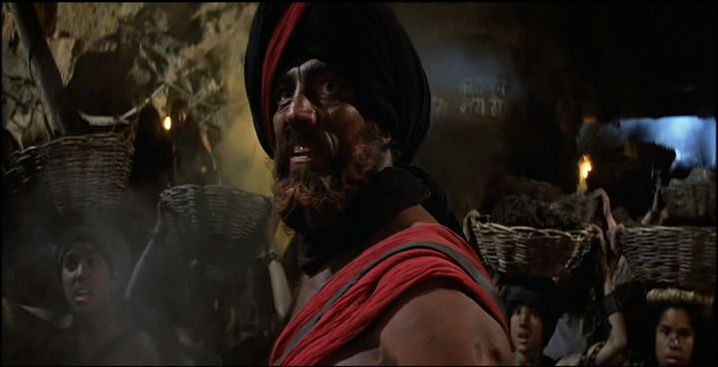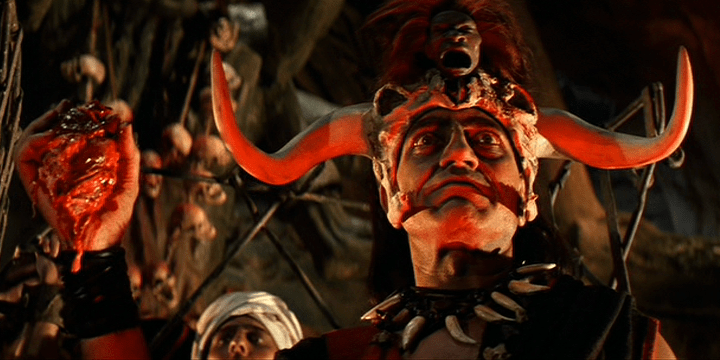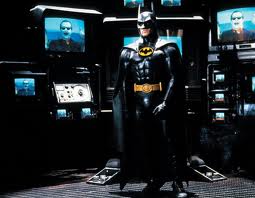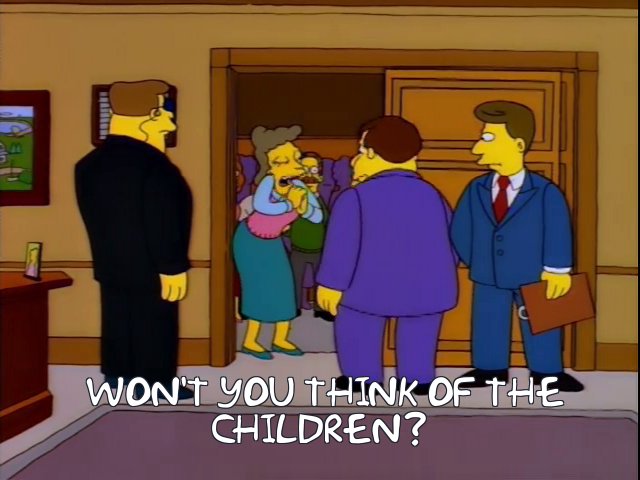Indiana Jones and the Temple of Doom is notorious for having helped necessitate the creation of the PG-13 rating in the United States. Let’s look back at why it ended up being so dark, and why the ratings were changed here but not in Britain.
Raiders of the Lost Ark tops off its throwback to old 1930s serials by literally melting the faces off of some evil Nazis, but Temple of Doom ups the weird (people eating eyeball soup and monkey brains), double downs on the ick (so, so many bugs) and has the villain rip a man’s still beating heart out of his chest. Then, for good measure, that villain ends up plunging to his death into the open mouths of hungry alligators. Oh, yeah, also, Indy maliciously slaps a kid in the face. Holy crap, George Lucas and Steven Spielberg! What the heck happened to you guys in-between Raiders and Doom?
Easy: they both had their own hearts ripped out.
As Lucas told Grantland, “People say, ‘Why’s it so dark?’ I was going through a divorce, and I was in a really bad mood. So I really wanted to do dark. And Steve then broke up with his girlfriend, and so he was sort of into it, too. That’s where we were at that point in time. Once [Spielberg and I] got out of our bad moods, which went on for a year or two, we kind of looked at it and went, ‘Mmmmm, we certainly took it to the extreme.’ But that’s kind of what we wanted to do, for better or worse.”
Lucas’ divorce, officially announced less than three weeks after the June 1983 release of Return of the Jedi, was from film editor Marcia Griffin. They’d been married since 1969. Spielberg’s break-up was with his girlfriend of three years Kathleen Carey. So, Temple of Doom is like the movie equivalent of a break-up album, like Bob Dylan’s Blood on the Tracks, except Blood on the Tracks is considered one of Dylan’s bests whereas Temple of Doom was everyone’s least favorite Indiana Jones movie until Kingdom of the Crystal Skull.
Lucas was still married, though not necessarily happily, in 1981/1982 when he and Spielberg hammered out the story details for what became Temple of Doom. At one point, Lucas was excited about making it a haunted castle movie set in Scotland, but Spielberg didn’t want to do another Poltergeist. At another point, it was going to be set in China, but then the Chinese government more or loss shot that down. By the time American Graffiti co-writers Gloria Katz and Willard Huyck came on board, Empire Strikes Back/Raiders of the Lost Ark’s Lawrence Kasdan’s had already passed on writing the script and the MacGuffin of the piece had become the Hindu’s Sankara Stones.
With Katz and Huyck’s help, Lucas’ original title, “Temple of Death,” was altered, and instead of Lucas’ proposal to have a virginal young princess as a sidekick, the writers came up with a plucky 10-year-old Chinese boy which eventually led to them having an entire subplot about kidnapped children.

Lucas wanted scary villains who were nothing like Raiders’ Nazis, and the writers found inspiration in The Thugs featured in George Steven’s 1939 version of the Rudyard Kipling poem Gunga Din. According to TheRaider.net, these people “were a sub-group among devotees of Kali, the goddess of Death, and they practiced ritual strangling – Thuggee – as a form of worship. Silent and anonymous traveling the roads of India, murdering travelers and burning them with their ritual pickaxes; the Thugs kept their sect and practices secret for centuries.”
Katz and Huyck had actually traveled through India, bringing home an ample supply of Indian art, including rare photographs of the Thuggee people. For the script, they mixed in some aspects of ancient Aztec, Hawaiian and European culture to make the film’s villains even worse.

Across what ultimately became an 18-week shoot – some in Sri Lanka, most on soundstages in London – Harrison Ford ruptured two disks in his back from all the elephant riding scenes. So, Indy was actually played for 5-weeks by Vic Armstrong, Ford’s stunt double. Even when he came back, Ford was in considerable pain. So, if it feels like Indy’s has lost his smile through much of the film it’s probably because the man playing him was in excruciating pain most of the time.
Or he was simply following Spielberg’s lead. As Huyck told Grantland about the film’s tone: “Steven took that child slavery and human sacrifice scenes very, very seriously. The kids were being whipped. It was very, very dark. Which was great — but, I mean, we were a little surprised by how seriously he took them.”
The finished film received a PG rating from the MPAA because it was clearly not dark enough for an R but far too grisly for a G. If only there was some other rating they could use…

When the film premiered in the United States on May 23, 1984, to bigger box office than Return of the Jedi from a year earlier, the onslaught of complaints from parents and reports of kids running from theaters in tears was instantaneous. The filmmakers went on the defensive, Spielberg pointing out in an interview “the picture is not called Temple of Roses, it is called Temple of Doom. There are parts of this film that are too intense for younger children but this is a fantasy adventure. It is the kind of violence that does not really happen and cannot be perpetuated by people leaving the cinema and performing those tricks on their friends at home.” Since then, Spielberg has repeatedly apologize for the film, reasoning the best thing he got out of it was his future wife, Kate Capshaw.
Huyck warned parents, “I would be very conscious in taking a kid to this movie, though. Hopefully, you know your child well enough to know what scares him and what doesn’t. But, obviously, if the kid began to get scared, I would leave.”
Katz echoed the sentiment: “I think it’s really up to parental discretion to decide whether a motion picture is too violent or not. I would probably not want an 8 or 10-year old child to see the movie. But kids, certainly, are so much more sophisticated now. […] We had to create a villain, and villains must do bad things. They just can’t say: ‘Hello, I’m a villain with capital ‘V’. With Nazis, you didn’t have to see what they did, because you know Nazis are bad. But here, you can’t have a watered-down villain. The audience must see evil, any kind of evil. You must show some of what that evil is in order to have to convincing fable. If anything, I feel it’s a problem with ratings system, not with the movie.”

The distributor, Paramount Pictures, seemed to agree, issuing the following warning: “This film may be too intense for younger children.” Harrison Ford conceded that such a warning seemed “fair enough” but he joined rank in defending the film, “This is a completely moral tale and in order to have a moral resolve, evil must be seen to inflict pain. The end of the movie is proof of the viability of goodness. But I do not like films that use violence in a reprehensible way. I do not seek out movies that are bathed in blood.”
What about movies bathed in a green-colored blood? Because that pretty well describes Gremlins, which came out two weeks after Temple of Doom. Produced by Spielberg and directed by horror aficionado Joe Dante, Gremlins gave parents and their kids a PG movie in which little violent creatures are torn apart in blenders and Phoebe Cates breaks off into a monologue about knowing Santa Claus isn’t real because, as IndieWire summarized, “her father died trying to climb down the chimney and surprise her one Christmas, and they only found him days later when the whole house started to smell.” That very same weekend saw the release of Ghostbusters, which has far more profanity in it than you probably remember.
Film nerd reaction: Holy crap! Temple, Gremlins AND Ghostbusters came out in the same two-week span? Best. Summer. Ever!
Long story short, within five weeks of Temple of Doom’s release the MPAA created the PG-13 rating, as covered in the following video:
That’s how things went down with the film in the United States. What about overseas in Britain, where film ratings are determined by the British Board of Film Classification? In 1984, their certificate system consisted of U (Universal), PG (Parental Guidance), 15 (Suitable for those 15 or older), 18 (Suitable for those 18 or older), and Restricted 18 (Only available at licensed cinemas). Did they also have to change their certificate system? Or did they simply give Temple of Doom a 15 certificate?
Well, things worked a little differently with the BBFC than the MPAA. The MPAA is so clandestine that decades later a documentary maker took to stalking its members to learn more about them. You submit your film to the MPAA and get a rating, and if you want a different rating you make some cuts and re-submit, making your best guess as to what material might have warranted the unwanted rating you received. You go through this dance as many times as it takes to get the rating you wanted, with many directors these days now contractually obligated to deliver a film which earns a PG-13.
The BBFC, on the other hand, delivers detailed reports back to filmmakers explaining their decision along with a list of scenes which could be cut in order for the rating to come down. Under that system, the BBFC instantly realized Temple of Doom was not a PG movie, not unless the heart-ripping scene was cut out. Here’s how the head of the BBFC broke the news in a letter to the distributor:
“There can be few films to which members of the BBFC looked forward with more pleasure than the sequel to Raiders of the Lost Ark, one of the great masterpieces of kids’ entertainment and possibly the most thrilling adventure film ever made.”
Stop, you’re making them blush.
“It is thus with real sadness, bordering on despondency, that we found ourselves, unanimously, confronted with the realization that Reels 4 and 4 of this sequel go far beyond the limits of the British ‘PG’ category that the film cannot be considered for a junior audience without cuts. There is absolutely no precedent in children’s entertainment in Britain for the very real world terror, ritual violence, black magic, and nightmare imagery which takes over this film quite suddenly in the Temple of Doom sequence. All of us at the Board are deeply concerned at the effect which these reels could have on a young audience, and yet boys of 8 or 9 upwards will be breaking down the doors of cinema all over Britain if we stop them seeing the sequel to Raiders.”
Wait, how do we even have this letter?
Well, the BBFC likes to create case studies of famous ratings controversies, and as part of that process, they release their actual initial reports for famous films. Here’s the one for Temple of Doom. You can even check out the one for Gremlins. Later in the Temple of Doom letter, the head of the BBFC points to a report from one of their members which perfectly summarizes why they felt the heart-ripping scene had to go:
There are moments when this film tips over into horror imagery, and the heroes are threatened by a kind of evil made manifest that is not easily perceived by a child as surmountable, because it’s not within childish fantasy vocabulary. A child will easily understand the threat of a teeming heap of insect life, because he or she knows that there are obvious ways of countering that threat. But children are not prepared for voodoo-inspired powers who are able to reach into live bodies and tear out pulsating hearts. This is an image for which there is no fantasy antidote because it is based in a conceptual leap that I don’t think many children have.
To get that PG, the UK theatrical version had to cut the heart-rip as well as several other scenes of violence against the heroes. When the movie came out on video in the UK in 1986 it was again the edited version and again received a PG rating.
 So, we think of Temple of Doom as the movie that gave us PG-13, but to the Brits the movie that did that for them was 1989’s Batman.
So, we think of Temple of Doom as the movie that gave us PG-13, but to the Brits the movie that did that for them was 1989’s Batman.
When Batman came out in the United States in June it was rated PG-13, which didn’t stop it from posting one of the biggest opening weekends of all time as a precursor to ending 1989 as the top-grossing film of the year. However, while Batmania overtook the US the Brits had to simply watch from afar, waiting for the film to finally cross the pond and open in early August. Their ratings system still hadn’t changed since 1984, and there was presumably some pushback against always getting sanitized versions of movies in order to fit into a PG rating. There was considerable industry pressure to make a change and avoid what happened in the US with Temple of Doom and Gremlins in ’84.
So, the BBFC introduced its PG-13 equivalent, although instead of using 13 as the cut-off age they used 12. The first film to receive this new 12 certificate was indeed Batman, which went through the BBFC with no cuts. Interestingly, since the 12 certificate didn’t come around until 1989 that means Temple of Doom remained available in the UK in only its BBFC-approved PG certificate version. The uncut version of the film wasn’t officially available until the 2012 DVD release received a 12 certificate.
Sources: TheRaider.net, Grantland, Empire, BBFC



This was a very interesting read/backstory. Thanks!
I agree. This was an interesting read. I was surprised that Lucas and Spielberg’s personal problems didn’t get mentioned in the Kate Capshaw article though.
I was trying to break temple of doom down into separate parts so I could have two very different articles, and I wrote the Capshaw article more about her experience making the film. Plus, none of the quotes I found, either recent or from 1984, from the people who made the movie actually said the treatment of Kate Capshaw ‘ s character was specifically related to Lucas going through a divorce or Spielberg going through a break-up. In fact, Capshaw now says there was a fair deal of flirting going on between her and Spielberg during filming, and back during the planning process when they were breaking the story Spielberg actually wanted to bring back Karen Allen’s Marion from Raiders indicating he initially wanted another strong female in the film. Lucas shot him down because he wanted a clean break from raiders which is why they made temple a prequel (well, that and also because a prequel would make it easier to have villains who are not Nazis). However, if I were to actually put forth more of an analysis I would have to assume Temple of Doom actively punishing its only female character and actually having Indiana almost kill her in truly horrific fashion is an obvious reflection of two guys working through some issues with women.